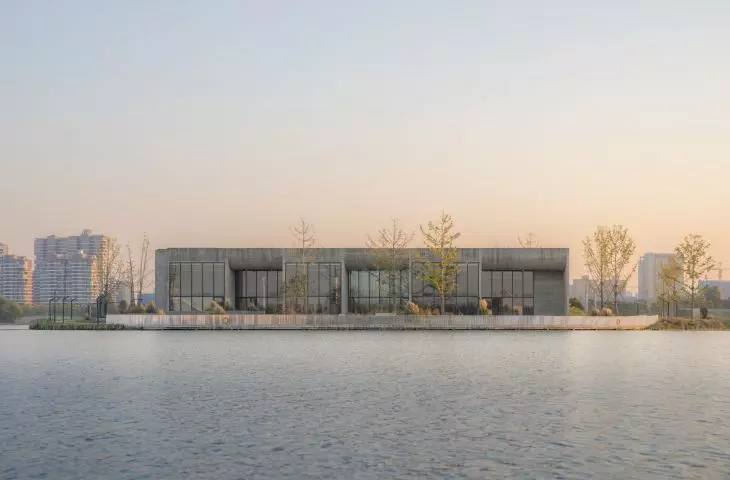Ginkgo Gallery,
design: MORE Architects
Ginkgo Gallery, located on China's Jiaxing Island, was designed by MORE Architecture, an office based in Shanghai and Amsterdam. Combining urban research, urban planning and urban design in its work, the studio draws on experiences from China and Europe. As a result, it has developed a sustainable urban planning model that combines top-down and bottom-up planning - where decisions by authorities and experts are complemented by the involvement of local communities, creating more functional and welcoming urban spaces.
Ginkgo Gallery is located on a ginkgo tree island in a lake in Jiaxing, China.
©Kris Provoost
a break from the "museum boom"
In recent years, China has experienced a so-called "museum boom," a surge in the number of impressive museum buildings. The Ginkgo Gallery is the opposite of this trend - its modest exterior is completely unlike a typical art institution. The architects, inspired by the structure of traditional villages in Zhejiang province, created a design that resembles a local settlement.
Ginkgo Gallery - visualization
©MORE Architecture
gallery inspired by village layout
The gallery building consists of a number of rectangular rooms, connected to each other by narrow passages. This layout is reminiscent of a country house, encouraging visitors to freely explore different parts of the building, as if they were visiting a small town.
Ginkgo Gallery - floor plan
©MORE Architecture
The ascetic form of the gallery
The lake-side façade consists of alternating overhanging glazed spaces, with solid concrete walls supporting curved panels. The concrete, used both inside and outside the building, was cast on site to reduce the number of materials used, thereby reducing transportation costs, construction waste and the need for additional packaging.
The Ginkgo Gallery is enclosed on the south side and features curved roofs
©Kris Provoost
It became clear early on in the design of Ginkgo Gallery that the museum's modest design required modest use of materials
- admitted the project team
Ginkgo Gallery - axonometry
©MORE Architecture
brutalist interiors
The gallery's interiors have a raw, brutalist character. The texture of concrete, achieved by casting scaffolding and boards, creates a raw, rough surface on the walls and ceilings. The exhibition halls are connected by passageways, allowing visitors to choose their own tour route.
Ginkgo Gallery's exhibition halls are connected by narrow passageways, allowing visitors to move freely and explore more spaces
©Kris Provoost
The architects combined two museum typologies - traditional guided tours and the ability to move freely. This allows curators to freely compose exhibition narratives to suit different needs.
Ginkgo Gallery - model
©MORE Architecture
light in a key role
The gallery was designed so that natural light evenly illuminates the exhibition spaces. The south side of the building is closed, while the north side is open, providing optimal lighting conditions. In addition, the height and size of the halls increase from the south toward the north, and the curved roofs filter daylight, enhancing its natural flow.
Ginkgo Gallery - cross section of the building
©MORE Architecture
dialogue with the environment
The gallery's surroundings play a key role in its perception. Just approaching the building, located on an island, is a unique experience. The exhibition begins in the sculpture garden, and the island area can be used for outdoor exhibitions, creating a harmonious space that blends architecture and nature.
Ginkgo Gallery creates a strong connection with the landscape and the lake
©Kris Provoost
The Ginkgo Gallery is an example of modern architecture that combines aesthetics with functionality and sensitivity to its surroundings. MORE Architecture's design refers to local traditions and raises questions about the future of urban planning and the relationship between humans and space.
Elaborated: Anastazja Dżupina
Illustrations provided courtesy of MORE Architects.




































































